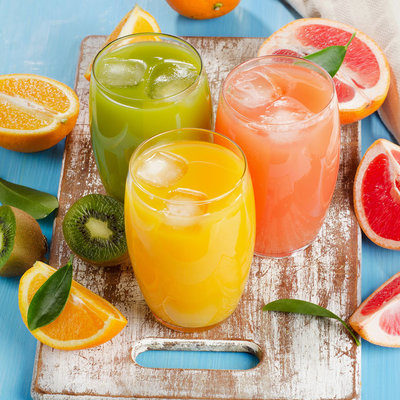
Fruit Juice
What is Fruit Juice?
Fruit juice is a drink made by extracting liquid from fruits. It is one of the most common fruit products after fresh fruits. Fruit juice comes in four different forms:
- simple juices (100% fruit)
- concentrated juices (50% fruit)
- dehydrated juices (powder form)
- nectarine juices (30-50% pulp).
Juice had a global market consumption of 45.4 billion liters in 2018. In the US, 5.8 gallons of juice were consumed per capita in 2018. Over the years, the consumption of fruit juices has reduced.
The top 10 juice brands in the USA, according to The Brand Boy are:
- Tropicana
- Simply Orange
- Minute Maid
- V8
- Ceres
- Langer’s
- Apple and Eve
- Ocean Spray
- Del Monte
- Florida’s Natural
Origin of fruit juices
The earliest mention of juicing can be found in the Dead Sea Scrolls before 150 BC, which refer to the mashing of figs and pomegranates to extract their juice. Fruit juice was occasionally extracted and consumed by different cultures, but the norm was still consuming whole fruits. There is proof that lemonade was consumed later in 10th century Arabia. Orange juice became popular in the US in the 1920s, when large quantities of oranges were produced due to industrialization.
The first juicing machine was invented in the 1930s by Dr. Norman Walker. Walker was a businessman who founded the juice movement while experimenting with carrots in France during his convalescence. Today, fruit juice is made from a variety of fruits and sometimes using a mix of different fruits in a single blend.
Function
This juice is commonly consumed as a beverage and can also be used to flavor other foods, especially desserts. You can use this juice to craft flavorful sauces, glazes, soups, and stews. Additionally, you can add it to baked goods for a sweet or tangy taste.
Nutrition
Fruit juice is filled with vitamins and minerals, as well as bioactive compounds, phytochemicals, calcium, folate, magnesium, potassium, and phosphorus all of which promote good health. Regular intake of juice can strengthen the immune system, keep blood pressure in check, and maintain bone health. On the downside, consuming this juice in excess can lead to obesity because of its high sugar content. Sipping it regularly may also affect dental health negatively. When consumed in moderation, this juice provides plenty of benefits for the human body.
Commercial production
Different fruits have varying procedures for making juice out of them, although all follow some basic steps. First, the fruit is picked and sorted, then washed and cleaned thoroughly. The fruits are then pressed and juice is extracted. Then, filtering and pasteurization takes place to get rid of any bacteria. Finally, fruit juice is either packaged or goes onto further processing to condense it into concentrates.
Fruit juice recipes
Juice can make desserts richer and more flavorful. Here are a few recipes:
FDA regulations
The FDA defines fruit juice as any beverage that contains any amount of juice derived from fruits. This definition applies to carbonated, noncarbonated, concentrated, full-strength, diluted, and all other forms of juice. There are very strict regulations governing the labeling of different types of fruit juice. Companies are required to specify the exact amount of juice present in the product on its label.
References
Clemens, Roger et al. “Squeezing fact from fiction about 100% fruit juice.” Advances in nutrition (Bethesda, Md.) vol. 6,2 236S-243S. 13 Mar. 2015, doi:10.3945/an.114.007328, https://www.ncbi.nlm.nih.gov/pmc/articles/PMC4352186/
Catteau, C et al. “Impact des jus de fruits et des boissons fruitées sur la santé de l’enfant et de l’adolescent: le point de vue du chirurgien dentiste” [Consumption of fruit juices and fruit drinks: impact on the health of children and teenagers, the dentist’s point of view]. Archives de pediatrie : organe officiel de la Societe francaise de pediatrie vol. 19,2 (2012): 118-24. doi:10.1016/j.arcped.2011.11.011, https://pubmed.ncbi.nlm.nih.gov/22206891/
